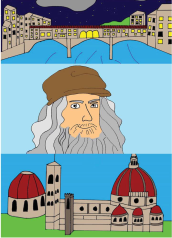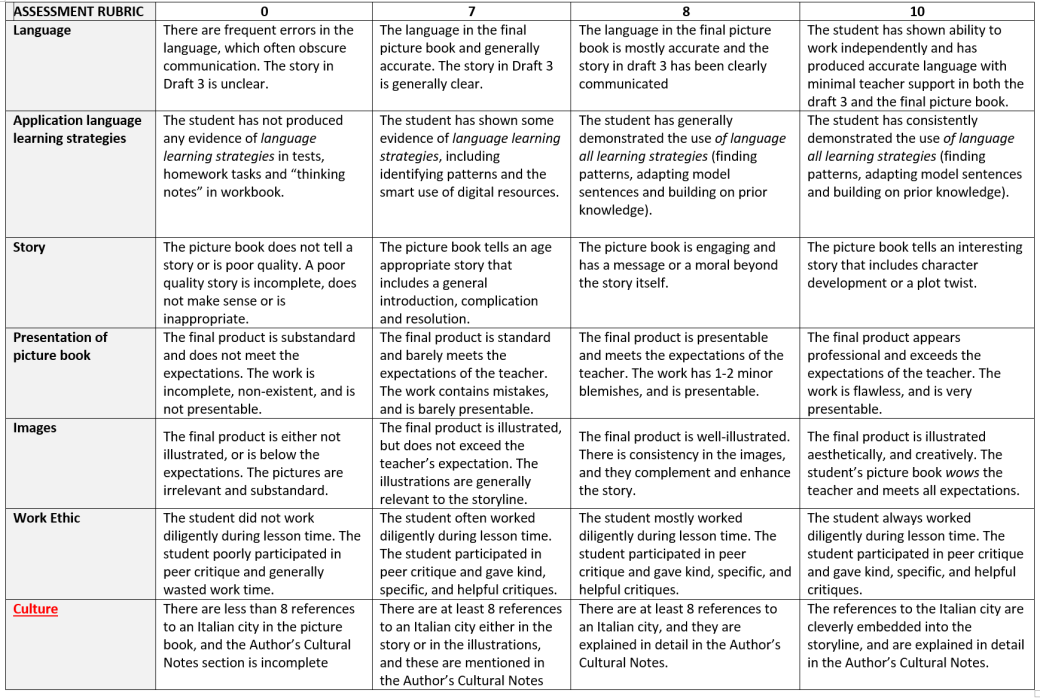Project Description | Adapting to Other subjects & Contexts | Teacher Reflection | Student Reflections
Students were tasked with producing a picture book that had custom illustrations/  photographs and an engaging story line (entirely in Italian!). The main learning goal was for students to learn language learning strategies, such as identifying patterns and adapting model sentences, while building on prior knowledge; moreover, students were engaged through a real-world book design project that allowed students to develop future-focused skills authentically.
photographs and an engaging story line (entirely in Italian!). The main learning goal was for students to learn language learning strategies, such as identifying patterns and adapting model sentences, while building on prior knowledge; moreover, students were engaged through a real-world book design project that allowed students to develop future-focused skills authentically.
*
Project Description
Context: Yr 7 Italian One Term Taster Course
Time: 9 weeks
Learning objectives: to learn language learning strategies, such as identifying patterns, adapting model sentences, and building on prior knowledge, in the context of typical beginner topics. To learn basic grammatical concepts (verb conjugations, noun-adjective agreement, etc), to explore what makes a good story and the power of images. To learn how to use online translating tools effectively. To learn how to add colour to an image using Photoshop.
Product: A picture book in Italian
Exhibition: Reading the picture books to a Yr 2 Italian class
Students had to produce a picture book in Italian. It had to be at least 8 pages in length, contain at least 16 sentences in Italian, and include 8 reference to an Italian city of the choice in the storyline and/or in the pictures. The main learning goal was for students to learn language learning strategies, such as identifying patterns, adapting model sentences, and building on prior knowledge, and to learn to use online translating tools effectively. Students had to create their story using simple sentences in the present tense, and then gradually translate their sentences as they learned how to conjugate verbs, make noun-adjective agreements, choose the correct article, etc. Students learned how to use online translating tools intelligently, by looking carefully at the context of suggested translations, and then following basic sentence structure and word order rules in Italian. They also learned to use online translating tools to create more accurate translations of their whole sentence. Finally, students learned Italian phonetics, practised pronouncing their sentences in front of the class, and then visited a primary school class at a local primary school and read their picture books to children. Students also had to hand in a process journal to prove their “smart thinking” for each sentence, which included how they applied language learning strategies to formulate their sentence in Italian. All the content of the course was delivered via blended learning.
Assessment rubric: (co-constructed with students)

Do you have any questions about the project description? Click here to add them to the comments section.
Adapting to other subjects & contexts:
All the suggestions, as well as the original project, can be multi-disciplinary. For example, the original project was implemented in a Language class but can be multi-disciplinary, involving Art (for the pictures), English (for exploring the driving question “what makes a good story” and for visual literacy), Design and Technology (for using Photoshop) and IT (making the connection between language learning and coding, through the language learning principle of “identifying patterns).
- English: creative writing; simplified picture book version of a novel
- History: picture book about an historical figure or period or event
- STEM: picture book about a famous scientist/mathematician/physicist featuring their theories
- Design & Technology: focus on the photoshop element
- Art: picture book about a famous artist; pictures painted in impressionist style / Picasso style, etc
- Service Learning: tactile picture books for the visually impaired
Do you have any other ideas teachers could find helpful? Click here to add them to the comments section.
Teacher Reflection
It was very satisfying to be able to teach students useful skills that go beyond the scope of my subject. I also really enjoyed the energy in the class each lesson as students were busy working on their books, and I was constantly walking around spending one-on-one time with each student. This also meant that I was able to get to know my students very quickly. It was so rewarding to see the excitement and pride on their faces when I would check a sentence they had formulated on their own using “smart thinking” and announce that it was correct, or better still when they were able to correct it themselves after a quick clue from me. I was very impressed by the fact that all students delivered on the day, despite the very tight schedule. I was blown away by their reflections after the excursion. The most common comments were “challenging but fun”, which is what I was aiming for.
I realised the value and need for a mini-project before starting the real one (I provided the pictures and students had to write a brief story to match). It allowed the students to “fail” and learn before the real product, and it also gave me the opportunity to “fail” and make changes to the real project. In fact, as a result of the practice book I introduced the “process journal”, which was a way for students to prove each of their sentences was formulated through “smart thinking”, rather than Google Translate.
Despite the process journal, there were still students who used Google Translate instead of smart thinking, especially with the Term 2 class. Consequently, for the third iteration of the project in Term 3, I decided to stop fighting against online translating tools and instead chose to embrace them and make them part of the project. One of my new objectives hence became that of teaching students to use online translating tools intelligently and effectively. I was very satisfied with this decision because it aligned with my teaching and learning philosophy.
Another change that I introduced in the second iteration was the cultural component. In Term 1 I had to comply with the Language Department’s Common Assessment Task – an end of term test which tested language (50%) and culture (50%); however, after my Coordinator of Learning saw the picture books my students created, I managed to convince her for Term 2 to allow me to use the picture book as the assessment task instead of the test. She agreed as long as I could provide her with both a mark for both language and culture. Consequently, I had to find a way to include culture into the book. Adapting an idea from the project I was designing for my Yr9/10 Italian class, I decided to that the picture books had to include at least 8 references (in the images or in the storyline) to an Italian city of their choice, that they would first have to research and present as a digital collage. This actually improved the quality of the picture books and demonstrated that constraints fuel, rather than hinder, creativity. In turn, this philosophy became the basis for a PBL unit I designed for a whole school project on fashion and positive psychology. It is also an effective story I share in my PBL presentations at conferences. Teachers often use syllabus constraints as an excuse to not innovate. Instead, I show them how parameters often make us more creative as we are forced to think outside the box to overcome certain restrictions.
Have you been fighting against Google in your subject or context too? How could you embrace Google instead? Click here to contribute your experiences, thoughts and ideas to the comments section.
Student Reflections
” … instead of doing dumb, boring normal tests we were allowed to use our minds creatively to produce a picture book which we would read out to year 2 students at Dobroyd Point Public School. This experience was really enjoyable and took a lot of effort.”
Antoinette, Yr 7
“This [project] was really hard by also extremely fun … it was fun because you could see that the year 2 students really enjoyed listening to our stories and talking to all of us about them. I found it really interesting to see what I could achieve in a short amount of time.”
Vanessa, Yr 7
Click here for more student reflections
Hi Celinda, this is all very intersting. It would be great if you could post a finished Picture Book, just to have idea of the final result.
LikeLike
Hi Michela – Here’s a student sample: https://www.dropbox.com/s/z1a93zgbja8br0y/Matthew%27s%20Picture%20Book%20Leonardo.pptm?dl=0
LikeLike
Celina,
Great project! thank you for sharing. I was wondering how you came up with an overall mark with so many different criterium?
LikeLike
Hi Angela,
If you take a look at the assessment rubric, you’ll see each element gets a mark out of 10. I simply added all the marks to give them an overall mark for the project. However, for their LOTE report, I only used the marks related to the language outcomes and ignored the others that did not relate to my subject.
LikeLike